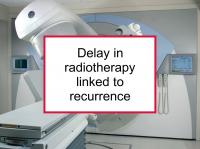A new study has found that the length of time between lumpectomy and the start of radiation treatment is related to the risk of local (i.e., confined to breast) recurrence. The study used data concerning 18,050 women in the Surveillance, Epidemiology, and End Results Program-Medicare database.
Subjects were diagnosed with stage 0-II breast cancer during the period 1991-2002, aged over 65, and received breast conserving surgery and radiation treatment, but not chemotherapy. The median time between surgery and the beginning of radiation treatment was 34 days. However, 30% of the women began radiation after an interval of six weeks or more.
Approximately 4% of the study group experienced a local recurrence. When cumulative risk by day was assessed, the association between delay and radiation was shown to be linear, i.e., the longer the delay, the higher the risk of local recurrence. Beginning radiation after a period of six weeks or longer since lumpectomy was associated with positive lymph nodes, concurrent non-cancer medical conditions, low income, non-white ethnicity, Hispanic ethnicity, later year of diagnosis, and residence outside the southern states of the U.S.
The authors conclude that there is a continuous relation between the time period between lumpectomy and radiation and local recurrence in older women, suggesting that starting radiation as soon as possible could minimize the risk of local recurrence. Furthermore, regions of the U.S. known to have increased rates of lumpectomy had longer intervals before radiation treatment, suggesting that capacity constraints play a role in delays.
